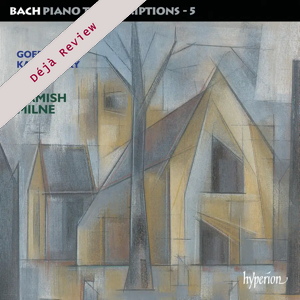
Déjà Review: this review was first published in June 2005 and the recording is still available.
Johann Sebastian Bach (1685-1750)
Piano Transcriptions Volume 5
Hamish Milne (piano)
rec. 2004, Henry Wood Hall, London, UK
Hyperion CDA67506 [72]
There is a long and noble tradition of Bach interpretation on the piano. These Russian versions chosen by Hamish Milne make an interesting contribution to its literature. Milne has both the technical resource and the musical imagination to make his own expressive point in the service of Bach’s remarkable and truly indestructible music. And taken as a whole his recital, judged on its own terms, will reward the listener with much pleasure. The recorded sound is pleasing, with a sensitive perspective and abundant clarity.
Some of the arrangers are better known than others. Alexander Siloti (1863-1945) was the teacher of Rachmaninov and himself a pupil of Liszt. He was therefore a pianist to be taken seriously, and these impressive transcriptions bring a new identity to music Bach composed in various other genres. The Prelude from the Cantata No. 35 and the beautiful Siciliano from the E flat Flute Sonata are highlights of the compilation, but on the debit side his version of the famous Air from the Suite No. 3 only goes to confirm how unpianistic this string music is.
The contributions of Alexander Goedicke (1877-1957) confirm his fine musicianship. Ironically for someone who made carefully considered piano transcriptions much of his reputation was made as an organ virtuoso. Perhaps what we have here represents a ‘labour of love’. In the case of Bach, it is always reasonable to suggest this. At any rate, Goedicke admitted his admiration for Ferruccio Busoni, the acknowledged master in this field, and his efforts do justice to his example, transferring his keyboard skill and understanding to the new medium with some powerful displays of sonority.
Dimitri Kabalevsky (1904-1987) is the best-known composer among these arrangers, who enjoyed a successful career in Soviet Russia. However, his transcription of the ‘Dorian’ Toccata and Fugue has fewer pianistic subtleties than its companion pieces. There is power and sonority in abundance, but the listener is unlikely to forget that this is organ music being played on the piano.
In fact it is the least known of these arrangers who has provided the most remarkable of these transcriptions. Georgy Catoire (1861-1926) made a career as a mathematician and businessman before turning to music later in life. But the delicacy and subtlety of his response to the challenge of transcribing the great Passacaglia in C minor are nothing short of extraordinary.
Through all this Hamish Milne again and again reveals his pianistic talents, and his playing also reflects his love of this demanding yet rewarding repertoire.
Terry Barfoot
Buying this recording via the link below generates revenue for MWI, which helps the site remain free.

Contents
Prelude and Fugue in G major, BWV541 (arr. Goedicke)
Prelude in B minor, BWV855a (arr. Siloti)
Prelude from Cantata, BWV35 (arr. Siloti)
Prelude and Fugue in D minor, BWV539 (arr. Goedicke)
Air from Suite No. 3, BWV1068 (arr. Siloti)
Adagio from Sonata in F minor, BWV1018 (arr. Siloti)
Fugue in C minor, BWV575 (arr. Goedicke)
Andante from Sonata in A minor, BWV1003 (arr. Siloti)
Passacaglia in C minor, BWV582 (arr. Catoire) [12.54]
Siciliano from Sonata in E flat major, BWV1031 (arr. Siloti)
Toccata and Fugue in D minor (Dorian), BWV538, arr. Kabalevsky [13.35]

















